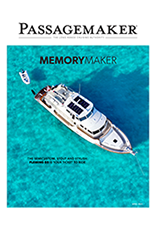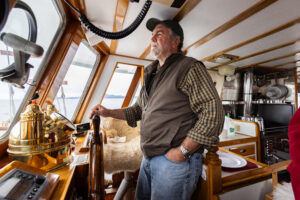Puffins. Lobstering. Obscure border disputes. If you’re interested in any of these, you’re likely to have heard of Machias Seal Island, the downright miniature island in the middle of the “gray zone” (or “grey zone”—the spelling of this word is one of the other things on which the United States and Canada are unable to agree).
But in the off chance that you’re not tuned into the worlds of rare birds, fishery management, or international relations, here’s the scoop: Machias Seal Island (along with the even more miniature island, North Rock) is the only landmass in the disputed waters between the U.S. and Canada. There are other current maritime disputes between the two countries. Foreign Policy notes a list (sourced from Wikipedia) that includes disputed waters in the Strait of Juan de Fuca (Washington/British Columbia); Dixon Entrance (Alaska/British Columbia); and Beaufort Sea (Alaska/Yukon). Even the Northwest Passage is contested as Canada claims it as “internal waters” while the U.S. officially refers to it as an “international strait.”

Maybe it’s because there’s land involved, even if it’s mostly uninhabited but for pairs of unnecessary Canadian lighthouse keepers and flocks of Atlantic puffins. Or maybe it’s because the name “Machias Seal Island” just begs for a good story. But of all these current border disputes, this one is hands down the most colorful.
Every few years it seems a story on some aspect of this disputed 20-acre island and its surrounding waters is printed in international and national publications as well as local papers. The Economist published a short article called “The Lobster Wars” in October 2007. And in 2012, Director of Canadian Studies at Duke University, Stephen R. Kelly, addressed the controversy in a New York Times op-ed with the title “Good Neighbors, Bad Border.” A former diplomat, Kelly urges the countries to take this dispute—which could easily be framed as an insignificant and even quaint quarrel—as a serious issue. Kelly writes, “[B]order disputes do not go away; they fester. And when other factors push them back to the surface—the discovery of valuable resources, an assertion of national pride, a mishap at sea—the stakes can suddenly rise to a point where easy solutions become impossible.”
And while tensions were relatively low in 2012, in large part due to the oversupply (and relatively cheap price) of lobsters, conflict between lobster boats from Maine and those from New Brunswick has been exacerbated in the past few years, making Kelly’s point all the more resonant. Because both countries claim ownership of the gray zone, which includes the 70 miles around the island, the agreement is that fishing vessels follow the fishery rules of their respective country (Canada) or state (Maine). And it’s easy to accuse the others of being responsible for perceived overfishing. In July 2015, Business Insider posted a blog titled, “The US and Canada are on the brink of a potentially deadly fight over lobsters,” citing a number of sources showing that hostilities between the countries’ fishermen were increasing with the rising price of lobst

While recent fluctuations in lobster prices have made this issue more topical in the past few years, the history of the dispute goes all the way back to the Revolutionary War. Since Machias Seal Island had never been settled, no one paid much attention to it when territories were being divided up in the Treaty of Paris, which officially ended the war in 1783. Though the treaty attempted to prevent any future border disputes, the series of lines and angles drawn up actually created this gray zone: As written, U.S. territory would include all islands within 20 leagues of U.S. shores, “excepting such islands as now are or heretofore have been within the limits of the said province of Nova Scotia.” While Machias Seal Island is only 10 miles off the Maine coast, well within the 20 league boundary, it is not clear if the island was then or heretofore had been part of Nova Scotia. The Canadians point to a 1621 land grant claiming all islands within six leagues of any part of the Nova Scotia coast. Signed in 1814 to end the War of 1812, the Treaty of Ghent could have decided this issue once and for all as Great Britain and the United States agreed on the ownership of specific islands. But Machias Seal Island was again not mentioned; the treaty just muddied the waters further, so to speak.
Two hundred years later, despite disputes over lobsters, the scene is pretty calm. Canada continues to maintain a lighthouse detail on the island. Though the lighthouse established there in 1832 is now fully automated, the Canadian Coast Guard flies in teams of two lighthouse keepers in shifts throughout the year for “sovereignty purposes.” Of course, on the U.S. side there have been sovereignty claims as well, though they seem a bit, um, less official than the efforts of the Canadian government. In a 2008 web-exclusive video interview with Maine Public Television, teenager Whitney Norton retells the “Legend of Jonesport,” the story of her ancestor Barna “Tall Barney” Beal, who was somewhere around six feet tall—but “back then six feet was really, really tall.” (Though other sources stick closer to the genre and claim his height was anywhere from 6’ 6’’ to 7’.) Back in 1865, Tall Barney wanted to “escape the war,” and so, according to local lore, he sailed his boat to Machias Seal Island. Norton notes that when he found Canadians (or British citizens at the time) living on the island, “the legend is he took every single one of them, one by one, and threw them off the island, literally.”

So what should determine who owns the island, the continuous residence of redundant lighthouse watchers or the legend of an American giant tossing the island’s inhabitants into the sea? We’ll have to wait and see how it all plays out.
But in the meantime, if you’re interested in the puffins, you should make sure to book a trip on Bold Coast Charters, which runs birdwatching tours aboard the Barbara Frost out of Cutler Harbor in Maine. They are already fully booked for the 2018 season, but make a note to check their website (www.boldcoast.com) first thing next January when they start taking reservations for the following summer. And if you’re really interested in the puffins (and other seabirds), the University of New Brunswick is currently hiring a Seabird Field Technician for the summer. According to the job posting, “Canadian residency or citizenship is preferred but not required.”







